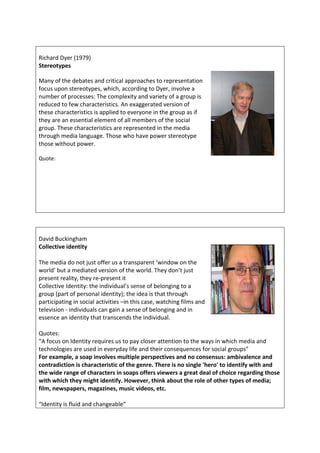
Media theorists revision cards
- 1. Richard Dyer (1979) Stereotypes Many of the debates and critical approaches to representation focus upon stereotypes, which, according to Dyer, involve a number of processes: The complexity and variety of a group is reduced to few characteristics. An exaggerated version of these characteristics is applied to everyone in the group as if they are an essential element of all members of the social group. These characteristics are represented in the media through media language. Those who have power stereotype those without power. Quote: David Buckingham Collective identity The media do not just offer us a transparent ‘window on the world’ but a mediated version of the world. They don’t just present reality, they re-present it Collective Identity: the individual’s sense of belonging to a group (part of personal identity); the idea is that through participating in social activities –in this case, watching films and television - individuals can gain a sense of belonging and in essence an identity that transcends the individual. Quotes: “A focus on Identity requires us to pay closer attention to the ways in which media and technologies are used in everyday life and their consequences for social groups” For example, a soap involves multiple perspectives and no consensus: ambivalence and contradiction is characteristic of the genre. There is no single 'hero' to identify with and the wide range of characters in soaps offers viewers a great deal of choice regarding those with which they might identify. However, think about the role of other types of media; film, newspapers, magazines, music videos, etc. “Identity is fluid and changeable”
- 2. David Gauntlet Identity is mediated Identity is now consciously constructed, and the media provides some of the tools to help us construct our identities. The media contains a huge number of messages about identity and acceptable lifestyles. At the same time the public have their own diverse set of feelings. The media and media consumers are engaged in a dialogue. Quotes: “Representations are only meaningful when processed in the minds of individual audience members” “The social construction of identity today is the knowing social construction of identity. Your life is your project. The media provides some of the tools which can be used in this work” Stanley Cohen (1972) Moral Panic HOW DOES IT WORK? According to Cohen, the media overreact to an aspect of behaviour which may be seen as a challenge to existing social norms. However, the media response and representation of that behaviour actually helps to define it, communicate it and portrays it as a model for outsiders to observe and adopt. So the moral panic by society represented in the media fuels further socially unacceptable behaviour Quotes: “A condition, episode, person or group of persons emerges to become defined as a threat to societal values and interests; its nature is presented in a stylized and stereotypical fashion by the mass media”
- 3. Stuart Hall Audience Reception Theory Preferred/dominant reading- when an audience accepts the message encoded in the text Negotiated reading- where an audience largely accepts what is encode in a text but draws on sociological and cultural contexts, personal experiences and opinions in order to create meaning Oppositional- when an audience rejects the encoded message Here the emphasis was put on audience reception and on texts open to more than one reading. What message is encoded by journalists, filmmakers, and what is decoded by audience Roland Barthes Mythologies Barthes theorized that mythologies are formed to perpetuate an idea of society that adheres to the current ideologies of the ruling class and its media He argues that an audience looks for signs to help them interpret what they see. How myths are constructed The signifier- a word, image, symbol, etc that can be interpreted The signified- the message behind the signifier The sign- the meaning, how we interpret the combination of the signifier and what is signified (the sum of the signifier and the signified).
- 4. Antonio Gramsci Cultural hegemony The ruling class create a ‘common sense’ ideology where their own ideologies and values become the norm. These ideologies and values are constantly being reassessed and redefined over time. The idea that there is such a thing as a ‘collective’ identity relies on individual assumptions that they share all or some of the same values, thoughts, beliefs, interests, customs, etc with a large amount of other people.